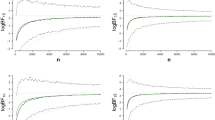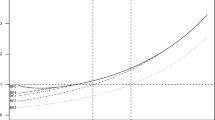Abstract
As a flexible Bayesian test criterion for nested point null hypotheses, asymmetric and multiple Bayes factors are introduced in the form of a modified Savage-Dickey density ratio. This leads to a simple method for obtaining pairwise comparisons of hypotheses in a statistical experiment with a partition on the parameter space. The method is derived from the fact that in general, the asymmetric Bayes factor can be written as the product of the Savage-Dickey ratio and a correction factor where both terms are easily estimated by means of posterior simulation. Analyses of a censored data problem and a serial correlation problem are illustrated for the method. For these cases, the method is straightforward for specifying distributionally and to implement computationally, with output readily adapted for required tests.
Similar content being viewed by others
REFERENCES
Berger, J. O. and Sellke, T. (1987). Testing a point null hypothesis: the irreconcilability of p values and evidence, J. Amer. Statist. Assoc., 82, 112–139.
Bertolino, F., Piccinato, L. and Racugno, W. (1995). Multiple Bayes factors for testing hypotheses, J. Amer. Statist. Assoc., 90, 213–219.
Chen, M. H. (1992). Importance weighted marginal posterior density estimation, Technical Report 92–22, Purdue University, Department of Statistics, Indiana.
Chib, S. (1995). Marginal likelihood from the Gibbs output, J. Amer. Statist. Assoc., 90, 1313–1321.
Devroye, L. (1986). Non-uniform Random Variate Generation, Springer, New York.
Dickev, J. (1971). The weighted likelihood ratio, linear hypotheses on normal location parameters, Ann. Statist., 42, 204–223.
Ferguson, T. S. (1967). Mathematical Statistics, A Decision Theoretic Approach, Academic Press, New York.
Gelfand, A. and Dey, D. (1994). Bayesian model choice: asymptotics and exact calculations, J. Roy. Statist. Soc. Ser. B, 56, 501–514.
Gelfand, A. and Smith, A. F. M. (1990). Sampling-based approaches to calculating marginal densities, J. Amer. Statist. Assoc., 85, 398–409.
Gelfand, A. E., Smith, A. F. M. and Lee, T. M. (1992). Bayesian analysis of constrained parameter and truncated data problems using Gibbs sampling, J. Amer. Statist. Assoc., 87, 523–532.
Gelman, A. and Rubin, D. B. (1992). Inference from iterative simulation, Statist. Sci., 7, 457–511.
Geyer, C. J. (1992). Practical Markov chain Monte Carlo (with discussion), Statist. Sci., 7, 473–511.
Hsiao, C. K. (1997). Approximate Bayes factors when a mode occurs on the boundary, J. Amer. Statist. Assoc., 92, 656–663.
Jeffreys, H. (1961). Theory of Probability, 3rd ed., Clarendon Press, Oxford, U.K.
Kass, R. E. and Raftery, A. E. (1995). Bayes factors, J. Amer. Statist. Assoc., 90, 773–795.
Lee, P. M. (1988). Bayesian Statistics: An Introduction, Wiley, New York.
Lewis, S. M. and Raftery, A. E. (1997). Estimating Bayes factors via posterior simulation with the Laplace-Metropolis estimator, J. Amer. Statist. Assoc., 92, 648–655.
Marr, R. L. and Quesenberry, C. P. (1991). A NU test for serial correlation of residuals from one or more regression regimes, Technometrics, 33, 441–457.
Newton, M. A. and Raftery, A. E. (1994). Approximate Bayesian inference with the weighted likelihood boostrap, J. Roy. Statist. Soc. Ser. B, 56, 3–48.
Ripley, B. (1987). Stochastic Simulation, Wiley, New York.
Tierney, L. (1994). Markov chains for exploring posterior distributions, Ann. Statist., 22, 1701–1762.
Tierney, L., Kass, R. E. and Kadane, J. B. (1989). Fully exponential Laplace approximations to expectations and variances of nonpositive functions, J. Amer. Statist. Assoc., 84, 710–716.
Verdinelli, I. and Wasserman, L. (1995). Computing Bayes factors using a generalization of the Savage-Dickey density ratio, J. Amer. Statist. Assoc., 90, 614–618.
Verdinelli, I. and Wasserman, L. (1996). Bayes factors, nuisance parameters and imprecise tests, Bayesian Statistics 5 (eds. J. M. Bernardo, J. O. Berger, A. P. Dawid and A. M. F. Smith), 765–771, Oxford University Press, New York.
Zellner, A. (1971). An Introduction to Bayesian Inference in Econometrics, Wiley, New York.
Zellner, A. (1987). Comment on ‘Testing precise hypotheses’ by J. O. Berger and M. Delampady, Statist. Sci., 2, 339–341.
Author information
Authors and Affiliations
About this article
Cite this article
Kim, HJ. A Method for Testing Nested Point Null Hypotheses Using Multiple Bayes Factor. Annals of the Institute of Statistical Mathematics 51, 585–602 (1999). https://doi.org/10.1023/A:1003962424859
Issue Date:
DOI: https://doi.org/10.1023/A:1003962424859




